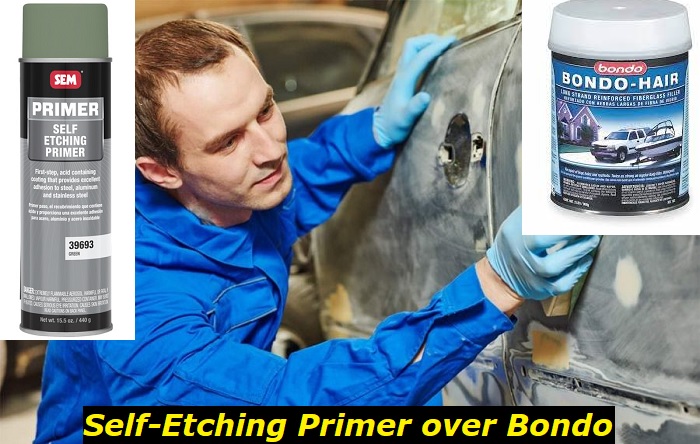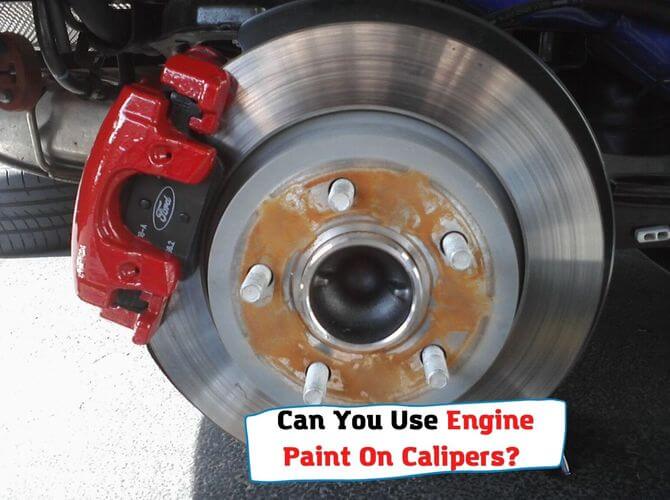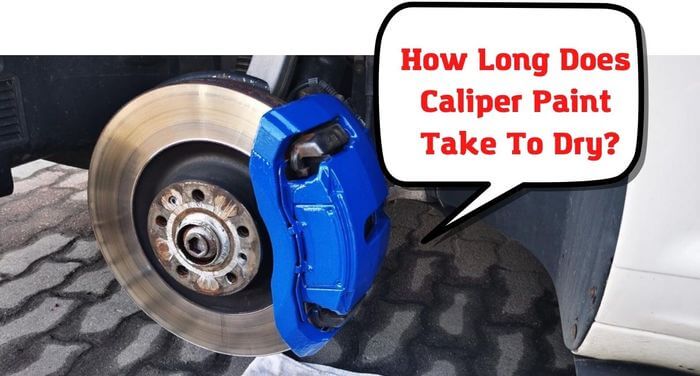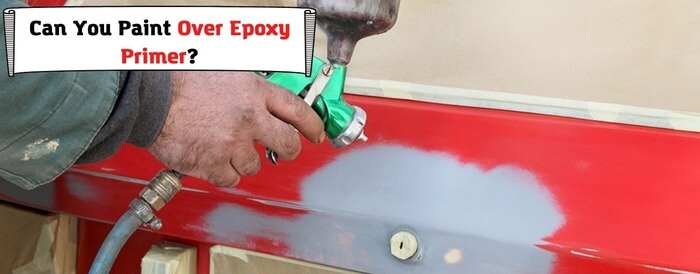Is it possible for a self-etch primer to go over Bondo? Many people have tried a self-etch primer over Bondo, and to their dismay, the finish is not what they expected. This seeks to answer the question: “Is it possible for a self-etch primer to go over Bondo?” The answer is yes, but the process can be difficult.
It is essential to be aware of the potential problems that can occur if you’re not careful. With some knowledge and planning, you can avoid these problems and get the best results from your self-etching primer and Bondo.

What is Bondo?
Bondo is a body filler to fix dings, dents, rust, and holes in automotive surfaces. It is made of a two-part resin and cures fast. Usually mixed with a hardener, it can be sanded or carved after it dries. This body filler makes it an ideal choice for automotive bodywork. Bondo may quickly conceal a welding seam, but it can make restoration projects a nightmare if used maliciously.
Common Problems with Applying Self-Etch Primer Over Bondo
The first problem with using a self-etch primer over Bondo is that it doesn’t create an effective rust barrier. If you put self-etching primer on steel or another ferrous metal, you need to protect it until you spray another layer. You may have to use another high-build primer to assist with blemishes on the surface.
The second problem with using a self-etch primer over Bondo is that it tends to absorb moisture or even sweat from the skin. This means that if you use a self-etch primer over Bondo, you’d better do so in an environment that doesn’t have high temperatures and offers optimal humidity.
The third problem with using a self-etch primer over Bondo is that it tends to peel off if you apply a second coat of primer. The peeling happens because the Bondo in between the panels of your vehicle is already a coating, so applying additional coats will only cause peeling.
Other problems are that it tends to have low adhesion potential. The latter means that self-etch primers used over Bondo usually have a rough texture similar to sandpaper. While this may be desirable if the primer is being used for metal surfaces, it is undesirable when applying it to areas where a smooth finish is required.
How to Apply a Self-Etch Primer Over Bondo Seamlessly
If you still want to use a self-etch primer over Bondo, use rubber gloves when handling self-etching primer because it can cause skin irritations for some people. Make sure you follow these easy steps:
- Clean the surface of your vehicle first with trisodium phosphate (TSP) or a concentrated car wash and gloss enhancer. Using these chemicals to clean will eliminate any traces of grease or oil.
- Let the surface dry with no humidity or warm temperatures. Depending on temperature and humidity levels, this could take up to 48 hours.
- Apply Bondo over your metal using a squeegee.
- Follow the directions carefully for the specific kit you used to apply your Bondo. Once the Bondo has been clamped, use spring steel to remove any excess from the panel’s surface.
- Allow 10 to 15 minutes to cure and sand afterward. Preferably, use 220-grit sandpaper for sanding. After sanding, ensure that there are no more dark leopard spots.
- Apply a self-etch primer. Make sure it is not a water-based primer. It would be best to use a solvent-based primer because it will not absorb moisture nor stick to your roller or brush.
- Allow the first layer of primer to dry at a temperature between 60-90 degrees F, depending on the climate conditions you are in. Do not use heaters or air conditioning to get your paint under control sooner.
- Put down the second layer of primer. This process will help ensure that your Bondo will be covered entirely.
- Allow the second layer of primer to dry.
- Begin sanding and apply a coat of paint. Let dry and repeat steps as needed until you achieve the desired results.
How to Best Use Self-Etch Primer
Metal is the primary material that self-etching primer is used on. You may use it on almost any type of metal, including steel, aluminum, brass, etc. While self-etching primer is practical on flat metal, it is beneficial for tasks where it is difficult to sand tiny crevices.
The primary distinction between self-etching primer and regular priming is the acid that is present. The acid creates a somewhat rough surface by eroding the surface and depositing zinc. You don’t have to sand your surface with the self-etching primer and this can save you quite a deal of time. It does the same tasks as hand sanding with little effort and improves adherence.
Self-etching primers can sometimes be used on hard plastics as well. Plastic objects frequently have smooth surfaces, making painting challenging. Plastic painting projects are more straightforward since self-etching primers may efficiently etch the surface to make it rougher. This process improves adherence.
Moreover, depending on the product you select, they can provide some protection to the underlying materials, avoiding scratches, oxidation, and more. Self-etching primer is frequently used in body shops and the automobile sector since it adheres to the materials mentioned above. It facilitates painting car exteriors without requiring manual sanding, increasing productivity. In the same way, you may use it for painting tasks involving metal toys, models, or miniatures.
How to Use Bondo and Primer for Maximum Metal Protection
When it comes to metal protection, a combination of epoxy primer and Bondo is the way to go. Epoxy primer is often used in industrial and automotive applications and provides a formidable, durable barrier that protects against corrosion and rust.
Bondo is applied over the primer to fill in dents and cracks. While Bondo and epoxy primer are ideal outside your car, the process is also helpful for minor dings and dents inside your vehicle.
Here’s how to use an epoxy primer and Bondo for maximum protection:
- Sand down any rust or corrosion on the affected area with coarse sandpaper. Be sure to remove all rust and paint as it may prevent bonding later.
- Clean the area where you apply epoxy primer and Bondo thoroughly with a degreaser.
- Apply epoxy primer to the affected surface and allow it to dry overnight before applying Bondo. For large dents, sand down rough areas and fill in with Bondo, following the same steps listed above.
- Sand the Bondo to achieve a smooth finish with sandpaper.
- Allow it to dry thoroughly before applying paint to ensure optimum durability against corrosion and rust.
Importance of Using the Right Tools When Using Self-Etch Primer Over Bondo
You can’t just use any tools when applying self-etch primer over Bondo body filler, especially if you want to get the best results. The ideal thing to do is to utilize the right tools to get a good finish. Here are some pointers for selecting the most ideal tools:
- Use a clean, dry cloth to wipe away any dust or debris from the surface before you start primer application.
- Use a high-quality self-etch primer specifically designed for use in automobiles.
- Apply the primer with a clean, dry brush or roller.
- Allow the primer to dry completely before painting or top coating.
- If you’re using a brush, clean it immediately after use with solvent to avoid clogging.
- If you’re using a roller, clean it with water and soap immediately after use.
- Use painter’s tape to mask off any areas you don’t want a primer on.
- Apply primer in thin, even coats.
- Allow each coat of primer to dry completely before applying the next coat.
- When you are finished, clean all tools and equipment with solvent or soap and water.
These tips will help you get the best results when using a self-etch primer over Bondo. Be sure to use the right tools and follow the instructions carefully to ensure a good finish.
Final Thoughts
Remember, using a self-etch primer over Bondo will be more complicated than most people like. If you want to do it correctly, you have to apply utmost care. Otherwise, everything will go wrong, and the outcome will not be what you would like it to be. In this way, your car will end up looking less than good, and even if you try for days with all of your strength, it might not be possible to achieve a satisfactory outcome.
The reason many people do so, however, is that they are looking for a way to save money. If this process saves you money, feel free to go ahead with it. However, if you are particular about getting a smooth finish, you might want to consider other techniques for applying a primer over Bondo.
- Can You Unmix Paint: Techniques, Consequences, Alternatives - February 23, 2024
- Does Primer Need to be Mixed? Effective Primer Application - February 22, 2024
- How to Make Old Paint Usable Again: Retrieving and Preserving Paint - February 21, 2024



